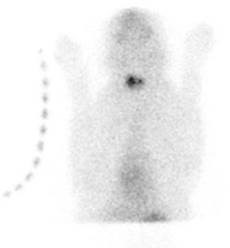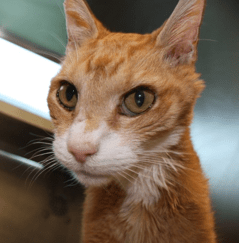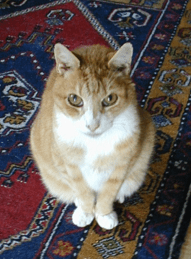-
Adopt
-
Veterinary Care
Services
Client Information
- What to Expect – Angell Boston
- Client Rights and Responsibilities
- Payments / Financial Assistance
- Pharmacy
- Client Policies
- Our Doctors
- Grief Support / Counseling
- Directions and Parking
- Helpful “How-to” Pet Care
Online Payments
Referrals
- Referral Forms/Contact
- Direct Connect
- Referring Veterinarian Portal
- Clinical Articles
- Partners in Care Newsletter
CE, Internships & Alumni Info
CE Seminar Schedule
Emergency: Boston
Emergency: Waltham
Poison Control Hotline
-
Programs & Resources
- Careers
-
Donate Now
FELINE HYPERTHYROIDISM
Feline hyperthyroidism is caused by a tumor of the thyroid gland (98% are benign). These tumors produce large amounts of thyroid hormone in the body. Excess thyroid hormone causes an increase in metabolic rate and is responsible for many of the signs we see in hyperthyroid cats such as weight loss, increased appetite, elevated heart rate, heart murmurs and arrhythmias, etc.
HOW RADIOACTIVE IODINE (I-131) THERAPY WORKS
The goal in treating hyperthyroidism (for benign tumors) is to destroy only the tumor cells in the thyroid and spare the normal thyroid cells. Ideally this should result in normal thyroid hormone levels and correction of weight loss and other clinical signs. For most cats, there is no need for daily thyroid medication after I-131 treatment. The goal in treating the more uncommon thyroid adenocarcinoma is to destroy ALL the thyroid tissue. After treatment, these patients will need daily thyroid supplementation for life.
Normally the thyroid glands take up iodine to be made into thyroid hormone. In hyperthyroid cats the high amount of thyroid hormone in the body causes normal thyroid cells to shut down (known as negative feedback). This spares the normal cells from the effects of the radiation. Tumor cells do not have this feedback so when given the radioactive iodine, the tumor cells pick that up as they would normal iodine. Radioactive iodine is taken into the tumor cells and kills them. Once the thyroid tumor cells are destroyed, the remainder of the thyroid tissue should perform normally again.
The success rate of I-131 is approximately 95-98%. A few patients may require an additional treatment with I-131 if they do not return to normal thyroid function within 3-6 months. A small percentage of cats will become hypothyroid (not produce enough thyroid hormone) and if this occurs it may be a temporary problem, or in some cats (~5%) may require thyroid supplementation.
ABOUT OUR PROGRAM
Your cat will be carefully screened for other diseases/conditions before being admitted for radioiodine treatment. The screening will consist of blood work, urinalysis, radiographs (x-rays), and possibly additional tests such as an ultrasound of the heart or abdomen. Often this is done by your veterinarian before your cat is referred for treatment.
We have veterinarians on staff who are specially trained in feline hyperthyroidism and I-131 therapy. These veterinarians are authorized by and work in conjunction with the Massachusetts Radiation Control Program to safely and effectively provide this treatment. A veterinarian from our I-131 team will examine your cat on or before the scheduled admission date. At that time it will be determined if your cat is suitable for this treatment, and any necessary additional testing will be arranged. Please call 617- 541-5186 to schedule. If your cat is on an anti-thyroid medication, such as methimazole, this must be discontinued at least one week prior to your cat’s scheduled admission date for treatment. Please consult with your veterinarian first about stopping the medication.
COST OF TREATMENT
- Varies slightly depending on preliminary diagnostics needed.
- Varies on length of stay.
- A full estimate will be given at the initial appointment or contact the hospital for current costs.
A-WARD: YOUR CAT’S HOME AWAY FROM HOME
During our appointment we will show you pictures of the ward and you will receive pictures of your kitty as often as possible during their stay.
- The I-131 ward is a limited access ward staffed by personnel trained to work with radioactive materials. Your cat will be in a comfortable cage away from commotion and barking dogs. We provide toys for distraction but we highly encourage you leave an old towel, shirt or some toys with the scent from home. Just don’t bring any favorites as they cannot be returned to you.
- We try to mimic feeding time at home. You can make a list of their daily routine and give it to us at the time of admission. For this reason, we also recommend you bring some of your cat’s favorite food so we change diets as little as possible, minimizing the chance of an upset stomach. We all know how much kitties like their own special flavors and textures. Let us know of any dietary allergies, likes or dislikes. We try to avoid fishy foods for the first 48 hours post treatment so as not to affect individual iodine levels. If this is all your cat likes, do not worry. It is more important that they eat something.
- At night, the lights are dimmed to allow your cat to experience normal sleep cycles.
- The ward has a high flow ventilation system (similar to that of a surgical suite) to avoid spread of upper respiratory infections. This is always a risk when cats are sharing airspace, but is not a regularly occurring issue in A-ward.
HOSPITALIZATION DURING AND POST I-131 TREATMENT
-
Length of hospitalization varies from 4-5 days (going home with restrictions) to 18-19 days (if your cat boards with us until all restrictions are lifted).
- Cats come in 1-2 days before treatment to become acclimated and have time to complete preliminary diagnostics.
- Massachusetts requires restrictions until 17 days post treatment. Please note, we cannot change this date. In some cases, we can send cats home with only contact restrictions if they monitor below a certain level.
- Once the I-131 treatment is administered (by injection) your cat cannot be released before the 3 days post treatment under any circumstances.
-
No visitation is permitted due to radiation safety concerns, but you will be contacted once daily with a progress report. When possible, we will email pictures of your kitty, as well. If you haven’t gotten a report by midday, feel free to call our main number for an update (617-522-7282) or email us. You will be given all of our contact info at the time of admission. We always want you to have access to updates, some days it just takes a little longer to take care of everybody and get those updates out. Rest assured, if there is ever anything abnormal or concerning going on we will contact you as soon as possible.
RESTRICTIONS AND RELEASE OPTIONS POST I-131 TREATMENT
- Angell offers the flexibility of variable release dates.
- Early Release – 3 days post treatment (we do thyroid scans and treat with I-131 on Wednesday so cats can go home on Saturday once they have been monitored with a Geiger counter to ensure their radiation levels are below the allowable limit). The nuclear medicine technician will confirm that your cat is ready to go home on Saturday morning if you plan on an early release.
- Boarding until no litter restrictions – varies cat to cat. After treatment we monitor their radiation level and once it is below allowable limits, litter does not need to be handled in a special manner (see restrictions sheet). This is most commonly around 10-14 days post treatment but can vary as it is based on your cat’s own metabolism. We will keep you updated daily with this measurement if you are interested in taking your cat home when they are off litter restrictions.
- Boarding until no restrictions (contact or litter) – 17 days post treatment, all restrictions will be up and you and your cat can resume your normal lifestyle.
- All of these options are discussed during the appointment with our I-131 veterinarian and a guideline of restrictions will be given to upon your cat’s admission to the hospital. You will sign this sheet regardless of whether you plan on an early release or to board until off restrictions. This is so we know you are aware of the restrictions if your plans change and you end up picking up your cat while some or all restrictions are still in place.
- When your cat is discharged from the hospital, another copy of the restrictions sheet will be included with your discharge instructions, unless it has been 17 days since treatment. It is imperative that you follow the restrictions as indicated both for your own safety and to avoid problems at your local trash processing facility. If you dispose of any contaminated litter in your trash can during the 2-week restriction period, Geiger counters at the trash disposal facility will likely detect it. This has resulted in costly expenditures of labor for cities and towns necessitated by locating the source. Fines have been issued to people improperly disposing of radioactive cat litter.
- I-131 Home Essentials Kit (if being released prior to 17 days post treatment):
- Flushable litter – Check pet supply stores for availability prior to release
- Brands include: World’s Best Litter (a few types), Oko Cat Litter, Cat’s Pride (a few types), Natures Miracle, Wheat Scoop, and many others
- Plastic bags – If you cannot flush litter, we can discuss storing the litter for 3 months before disposal into the trash facilities.
- Plastic (rubber) gloves
- Flushable litter – Check pet supply stores for availability prior to release
I-131 TREATMENT DAILY SCHEDULE (ONCE ADMITTED)
- Monday/Tuesday:
- Monday appointment for admit is for cats never seen by an I-131 veterinarian before – we have an appointment for a physical exam and discussion of radioactive iodine treatment and restrictions. Your cat is admitted from this appointment.
- Monday/Tuesday Drop off for cats previously seen by an I-131 veterinarian. You can bring your cat in Monday between 7:00am – 4:00pm or Tuesday by 10:00am the latest.
- If you cannot make these times, please notify i131@angell.org.
- If needed, repeat blood work and x-rays are done. This is ensure nothing has changed since your veterinarian did these tests. Our goal is to make sure your cat is as healthy as possible before treatment and we will discuss the results of all these tests prior to proceeding with the radioactive iodine treatment. We want you to feel comfortable that this is the best treatment option for your cat. We have Tuesday to do any additional testing that would be needed if something abnormal showed up on our screening tests Monday. Otherwise, Tuesday is a day for them to acclimate to their temporary home, and to us!
- Wednesday:
- A thyroid scan (also called a technicium-99 scan) is done to determine if one or both lobes of the thyroid gland are involved. If your cat is too difficult to handle, a tranquilizer may be given. After all the information has been gathered, a dose of radioactive iodine (I-131) is determined and then administered as one injection on Wednesday afternoon.
- Thursday/Friday:
- From this point on, your cat is “boarding” here as the amount of radiation in their body decreases. Our priorities are to ensure your cat is comfortable and eating. We try to provide all the comforts of home. If you like, you can provide a voice recording (email or even drop off a cassette tape), and we will play it for your cat. If your cat has any music preferences, let us know! We typically leave a classical radio station on for them 24/7.
- While your cat is here post treatment, full physical exams are not done daily to reduce radiation exposure. That being said, all cats are observed by a technician three times daily and appetite, bowel movements, etc. are recorded and added to their medical record. A doctor will be made aware of anything abnormal. If you have any questions about this, please feel free to ask.
- Either an A-ward technician or a call center representative will update you daily by email or by phone. If possible, a photo of your cat will be included in the email updates. An I-131 veterinarian will be in contact if there are any issues with your cat but also just to check in every few days so don’t be alarmed if she calls you personally. Feel free to email i131@angell.org with questions at any time.
- Saturday:
- After cleaning and feeding, we monitor the cats with a Geiger counter for the first time since being treated. Those owners looking to have their cat released early will be notified whether or not their cat is “okay to go home with all restrictions” as soon as we are finished taking care of all the cats (usually by 10am). A discharge time will be set up during that phone call.
- Sometimes cats will monitor too high to go home on Saturday but this does not happen to the majority of cats. If your cat does monitor too high to go home, we will continue monitoring them every day until they are okay to go home.
- If you would like us to not feed your cat breakfast the day of discharge due to a history of car sickness, let us know ahead of time. We can also give an anti-nausea medication in advance so it will take effect by the time you come in to pick them up.
- Sunday onward:
- See Thursday/Friday above
Contact
350 S. Huntington Avenue
Boston, MA 02130
Phone: 617-522-7282
Email: i131@angell.org
Fax: 617-989-1657
Pre-Treatment Requirements
Pre-Treatment Requirements
Download the pre-treatment requirements checklist here.
Click to Download

